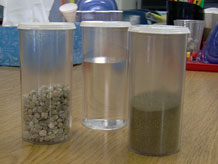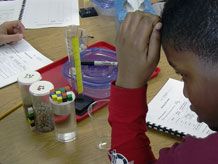How can we keep track of our mini-lake materials?
1. Review volume
In the last session, students carefully weighed each material that will be used to make their mini-lakes. Today they measure the volume of the sand, gravel, and water and then construct their mini-lakes. They don't measure volume of the rocks, which have been weighed and can be counted.
Explain that knowing the amount of these materials will help them to keep track of changes that may occur in their mini-lakes. They have one more set of important measurements to make.
Introduce the investigation question:
How can we keep track of our mini-lake materials?
Distribute materials. Ask students to leave the caps on the vials for now and to set the vial of rocks aside. The rocks will be the last material added to the mini-lakes.

Review the concept of volume
- The volumes (amount of space each material takes up) are different. The water sample has the greatest volume. The sand sample has the least volume.
Highlight the three-dimensional nature of volume measurement, for example, by enclosing a space with your two hands, as if you were holding a large ball.
Have students pick up a centimeter cube. The cubic centimeter is the unit of measure for volume, just as the gram is the unit of measure for weight. One cube takes up one cubic centimeter of space.
Estimate volume
Ask students to estimate the volume of their sample of sand.
Note: The volume of sand ranges from approximately 75cc to 95cc, depending on the weight a team was assigned. The goal of having students make this estimate is to see if they focus on the amount of space taken up by the sand. Do they confuse volume with the height of sand in the vial, the perimeter of the vial, the area of the vial bottom, or possibly the weight of the sand? Students are not expected to generate an accurate estimate.

Tell students to work in pairs, and that they'll have just a few minutes to make this volume estimate and record it in their Science Notebooks. Note that different pairs of students have different volumes of sand. Students record their data on the [Making mini-lakes] page in their Science Notebooks.
Ask students to share their estimates. Listen for estimates that seem surprisingly low (did they confuse volume with height, area, or perimeter?), and ones that are equal to the weight of their sand (did they confuse volume with weight?). Ask a few students to describe how they arrived at their estimate.



